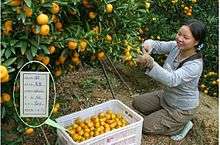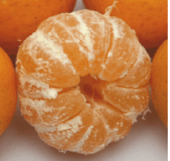Kishu mikan
.png)
The kishu mikan (Citrus kinokuni ex Tanaka) is a hybrid variety of mikan, or mandarin orange (Citrus reticulata), found in Southern China and also grown in Japan.[1] It is not closely related to the common sweet orange, but it is closely related to the mandarin orange.
The fruit is also known as Baby Mandarin, Tiny Tangerine, Mini Mandarin and Kishu Mandarin. It is sold under the brand name "Cherry orange" in Europe. It is shaped like a mandarin, between 25 and 50 mm in diameter. The fruit's orange skin is thin and smooth.
Some varieties of kishu,[2] such as the mukakukishu, are seedless.[3] The species is used in creating seedless hybrid citrus.[4] The largest variety is the hirakishu.[3]
History

The fruit is thought to have arisen in Southern China, where its name was recorded in the records of Jianchang during the Ming Dynasty, and its agricultural growth is widespread in Jiangxi province. Japanese oranges were cultivated from the cherry orange about 700 years ago. Genetic studies have found it to be closely related to the Huanglingmiao mandarin, carrying the same pomelo (Citrus maxima) introgression, indicating that the two diverged from the same backcrossed domesticated ancestor.[5] Under the Tanaka system of citrus taxonomy, it is a separate species, Citrus kinokuni, while the Swingle system groups it with other pure and hybrid mandarins as a single species, Citrus reticulata.

The Chinese government recently ranked the fruit as one of the best fruits in China.
The cultivar was developed for commercial production starting in 1983 at the University of California Citrus Research Center, and the fruit is now commercially available at specialty markets throughout California.[6] [7]
The fruit was made available in Europe in 2006. It started to be widely grown in the United States around 2010.[2]
Taste
The fruit is sweet and, like other mandarins, high in vitamin C. The fruit is enveloped in a thin skin (0,11 cm) and has 7–19 sections. One variety is seedless; others have seeds.[2]
Cultivation
The trees bloom in April. The fruit only grow to a size of 25–45 mm and are harvested in November. Each tree produces about 40 kilograms of fruit per year. The fruit must be handled with care to avoid damage to the skin.
Peeling method
A fruit is peeled by taking it in both hands with thumb nails at the top and gently breaking it in two. Then the skin is peeled away.
See also
References
- ↑ http://sciencelinks.jp
- 1 2 3 "The Seedless Kishu, a small but mighty mandarin". latimes.
- 1 2 "Kishu". citrusvariety.ucr.edu.
- ↑ Chavez, Dario J.; Chaparro, José X. (1 May 2011). "Identification of Markers Linked to Seedlessness in Citrus kinokuni hort. ex Tanaka and Its Progeny Using Bulked Segregant Analysis". HortScience. 46 (5): 693–697. ISSN 0018-5345.
- ↑ Wu, Guohong Albert; Terol, Javier; Ibanez, Victoria; López-García, Antonio; Pérez-Román, Estela; Borredá, Carles; Domingo, Concha; Tadeo, Francisco R; Carbonell-Caballero, Jose; Alonso, Roberto; Curk, Franck; Du, Dongliang; Ollitrault, Patrick; Roose, Mikeal L. Roose; Dopazo, Joaquin; Gmitter Jr, Frederick G.; Rokhsar, Daniel; Talon, Manuel (2018). "Genomics of the origin and evolution of Citrus". Nature. 554: 311–316. doi:10.1038/nature25447. and Supplement
- ↑ "kishu". University of California Riverside Citrus Variety Collection.
- ↑ "Kishu Tangerine". www.specialtyproduce.com.